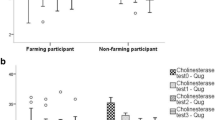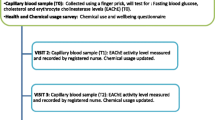Abstract
Organophosphate and carbamate pesticides have been widely used by farmers for crop protection and pest control. Inhibition of acetylcholinesterase (AChE) in erythrocyte and butyrylcholinesterase (BChE) in plasma is the predominant toxic effect of organophosphate and carbamate pesticides. Mae Taeng District, Chiang Mai Province, is one of the large areas of growing vegetables and fruits. Due to their regular exposure to these pesticides, the farmers are affected by this toxicity. The objective of the study was to examine the AChE and the BChE activity levels in the blood of 102 farmers for comparison of exposure in two cropping seasons, winter and hot. Blood samples were collected in December 2013 (winter) and April–June 2014 (hot). A total of 102 farmers joined the study, represented by 76 males (74.5 %) and 26 females (25.5 %). The age of most of the farmers was 53.4 ± 8.7 years. Out of 102, 21 farmers used carbamate pesticides. The results showed that the AChE and the BChE activity levels of all the farmers were 3.27 ± 0.84 Unit/mL and 2.15 ± 0.58 Unit/mL, respectively. The AChE and the BChE activity levels in males were 3.31 ± 0.88 Unit/mL and 1.97 ± 0.60 U/mL, respectively, during winter and 3.27 ± 0.82 Unit/mL and 2.15 ± 0.58 U/mL, respectively, during the hot season, and AChE and the BChE activity levels in females were 3.27 ± 0.82 U/mL and 2.44 ± 0.56 U/mL, respectively, during the hot season. The cholinesterase activity levels, both AChE and BChE, in the male farmers’ blood had significant difference between the two seasons, while in the case of the female farmers, there was significant difference in the BChE activity levels, at p < 0.05. The BChE activity level was found to significantly correlate with self-spray (p < 0.05), which implies that the BChE activity decreased when they sprayed by themselves. The cholinesterase activity levels of the present study were lower than those of the other studies, which may be an indication of some chronic effect of exposure to anticholinesterase pesticides. Thus, it is recommended that the use of pesticides be decreased, together with increase in the awareness of the impact of pesticides on health; also recommended is regular monitoring of blood cholinesterase.

Similar content being viewed by others
References
Ames RG, Brown SK, Mengle DC, Kahn E, Stratton JW, Jackson RJ (1989) Cholinesterase activity depression among California agricultural pesticide applicators. Am J Ind Med 15(2):143–150
Areekul S, Srichairat S, Kirdudom P (1981) Serum and red cell cholinesterase activity in people exposed to organophosphate insecticides. Southeast Asian J Trop Med Public Health 12(1):94–98
Bardin PG, van Eeden SF, Moolman JA, Foden AP, Joubert JR (1994) Organophosphate and carbamate poisoning. Arch Intern Med 154(13):1433–1441
Chakraborty S, Mukherjee S, Roychoudhury S, Siddique S, Lahiri T, Ray MR (2009) Chronic exposures to cholinesterase-inhibiting pesticides adversely affect respiratory health of agricultural workers in India. J Occup Health 51(6):488–497
Chan LFSB, Delilkan AFF, Huat L (1994) Blood cholinesterase levels in a group of Malaysian blood donors. Malays J Pathol 16(2):161–164
Coye MJ, Lowe JA, Maddy KT (1986) Biological monitoring of agricultural workers exposed to pesticides: I. Cholinesterase activity determinations. J Occup Med 28(8):619–627
Ellman GL, Courtney KD, Andres V Jr, Featherstone RM (1961) A new and rapid colorimetric determination of acetylcholinesterase activity. Biochem Pharmacol 7(2):88–90
Gonzalez V, Huen K, Venkat S, Pratt K, Xiang P, Harley KG, Kogut K, Trujillo CM, Bradman A, Eskenazi B et al (2012) Cholinesterase and paraoxonase (PON1) enzyme activities in Mexican-American mothers and children from an agricultural community. J Expo Sci Environ Epidemiol 22(6):641–648
Halbrook RS, Shugart LR, Watson AP, Munro NB, Linnabary RD (1992) Characterizing biological variability in livestock blood cholinesterase activity for biomonitoring organophosphate nerve agent exposure. J Am Vet Med Assoc 201(5):714–725
Hofmann JN, Keifer MC, Checkoway H, De Roos AJ, Farin FM, Fenske RA, Richter RJ, van Belle G, Furlong CE (2010) Biomarkers of sensitivity and exposure in Washington state pesticide handlers. Adv Exp Med Biol 660:19–27
Innes DF, Fuller BH, Berger GM (1990) Low serum cholinesterase levels in rural workers exposed to organophosphate pesticide sprays. S Afr Med J 78:581–583
Khan DA, Shabbir S, Majid M, Naqvi TA, Khan FA (2010) Risk assessment of pesticide exposure on health of Pakistani tobacco farmers. J Expo Sci Environ Epidemiol 20:196–204
Lander F, Hinke K (1992) Indoor application of anti-cholinesterase agents and the influence of personal protection on uptake. Arch Environ Contam Toxicol 22(2):163–166
Makrides C, Koukouvas M, Achillews G, Tsikkos S, Vounou E, Symeonides M, Christodoulides P, Ioannides M (2005) Methomyl-induced severe acute pancreatitis: possible etiological association. JOP 6(2):166–171
Mwila K, Burton MH, Van Dyk JS, Pletschke BI (2013) The effect of mixtures of organophosphate and carbamate pesticides on acetylcholinesterase and application of chemometrics to identify pesticides in mixtures. Environ Monit Assess 185(3):2315–2327
Pongraveevongsa P, Ruangyuttikarn W (2000) Measurement of serum cholinesterase level in normal Thai people. Chiang Mai Med Bull 39(1–2):21–29 (In Thai)
Roldan-Tapia L, Nieto-Escamez FA, del Aguila EM, Laynez F, Parron T, Sanchez-Santed F (2006) Neuropsychological sequelae from acute poisoning and long-term exposure to carbamate and organophosphate pesticides. Neurotoxicol Teratol 28(6):694–703
Acknowledgments
This study was funded by the Environmental Research and Training Center (ERTC), Department of Environmental Quality Promotion, Ministry of Natural Resources and Environment, Thailand. All laboratory facilities were supported by the Research Institute for Health Sciences, Chiang Mai University.
Author information
Authors and Affiliations
Corresponding author
Additional information
Responsible editor: Philippe Garrigues
Rights and permissions
About this article
Cite this article
Hongsibsong, S., Kerdnoi, T., Polyiem, W. et al. Blood cholinesterase activity levels of farmers in winter and hot season of Mae Taeng District, Chiang Mai Province, Thailand. Environ Sci Pollut Res 25, 7129–7134 (2018). https://doi.org/10.1007/s11356-015-4916-6
Received:
Accepted:
Published:
Issue Date:
DOI: https://doi.org/10.1007/s11356-015-4916-6




